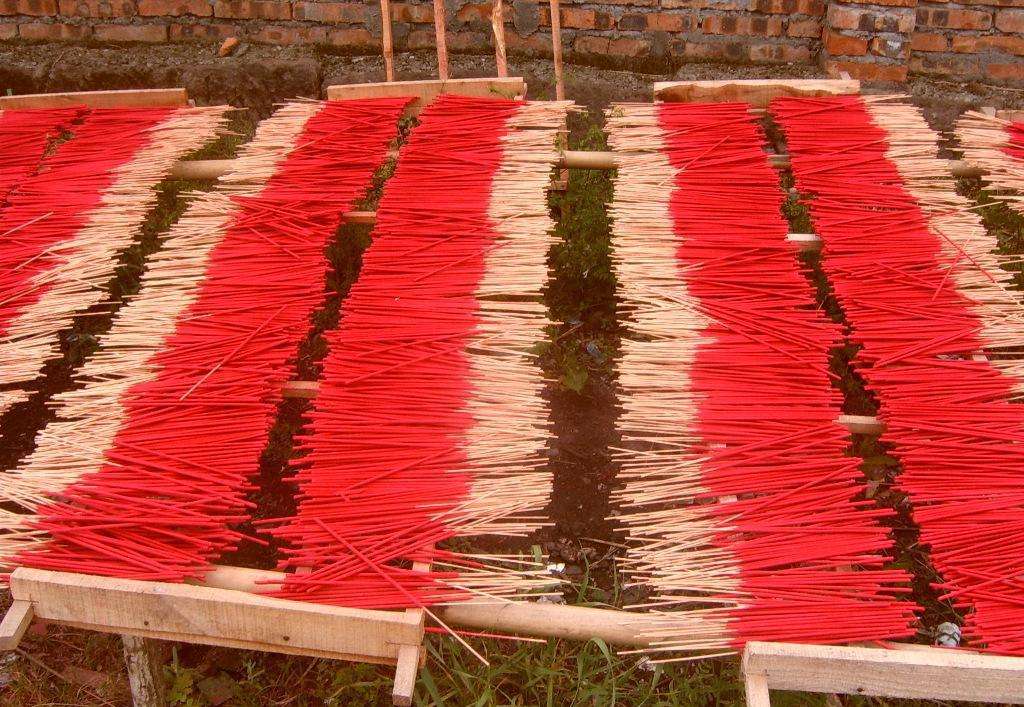What are the methods for making Jiangmen bamboo stick incense
Fragrance not only needs to nourish the nose with fragrance, but also needs to nourish the mind, nourish the body, and enlighten the mind. This is a central principle of traditional fragrance making techniques. It is precisely because of adhering to this concept that traditional fragrances have become not only aromatic substances, but also medicines for promoting wisdom and health. Throughout the long historical period from the Qin and Han dynasties to the Ming and Qing dynasties, they have won wide popularity from all walks of life in society.
Comparatively speaking, modern fragrance making processes based on chemical technology mainly focus on the aroma of the scent, rather than the health benefits of the fragrance. This concept affects various aspects of fragrance making. For example, in order to improve production efficiency, reduce material costs, and beautify the appearance of fragrances, many chemical preparations, including chemically synthesized fragrances, are used, and many purely industrialized production methods that are considered harmful to fragrances in traditional processes are adopted.
Regarding the production of incense, China has already formed a complete set of theories in ancient times that are in line with traditional Chinese medicine and Taoist external pill theory. There is a very mature and perfect craftsmanship system, which is also an inseparable part of China's traditional civilization. There is a rigorous and effective set of methods and standards in the establishment of fragrance formulas, the use of spices, compatibility and counterfeiting, and the manufacturing process.
It can be said that traditional fragrance making techniques seek to nourish the mind with fragrance, while modern fragrance making techniques seek to nourish the nose with fragrance. The difference between the two types of fragrances is very obvious.

To produce traditional fragrances, the first step is to comprehensively consider the use, fragrance type, grade and other factors of the fragrance, and then select spices or medicinal materials according to the requirements of these foundations, and mix them according to the combination of Jun, Chen, Zuo, and Fu. As long as the ruler, minister, assistant, and helper are in their respective positions, they can fully display the nature of different spices. For example, yamen incense, xinxiang, gongxiang, weixiang, and medicated incense each have their own principles and methods, but their ingredients are all confirmed based on the deduction of the Five Elements, Six Qi, Five Elements, and Heavenly Stems and Earthly Branches for the ruler, minister, assistant, and support.
Nowadays, it is common to see single item incense such as sandalwood on the market, so many people mistakenly believe that this type of single item incense is the main body of traditional incense, which is a big misunderstanding. Just as a single traditional Chinese medicinal herb, even if precious, is not a good medicine, a good spice is not necessarily a good fragrance. For example, regarding sandalwood, ancient people have clearly stated: "When sandalwood is burned alone, it is easy to float on the surface, and over time it will make the gods uneasy
In fact, as early as the Han Dynasty, ancient people had already realized the limitations of single aroma and developed the concept of spice compatibility, starting to use a combination of multiple spices to form a fragrance. From the "Four point Incense Burner" in the early Western Han Dynasty, it can be seen that Hexiang was already about to emerge at that time. After the Han Dynasty, the compatibility level of spices continued to improve, and the variety of fragrance formulas became increasingly rich. Until the Ming and Qing Dynasties, blended fragrances were the mainstream of traditional fragrances. It is only in modern times that the decline of fragrant civilization has led to the current situation of retreat.
Traditional fragrances are not only highly refined in terms of spice compatibility, but also have strict requirements for the counterfeiting of spices. "If it is not enough, the effect is difficult to achieve, and if it is too much, the flavor will be lost." Whether the counterfeiting is appropriate or not directly affects the quality of the fragrance. The counterfeiting of spices has similarities with the counterfeiting of traditional Chinese medicine, but there are also many differences. The same spice is often counterfeited differently when used in different fragrances. Overall, the purpose of counterfeiting fragrant materials is twofold: firstly, to remove impurities and facilitate their use; secondly, to guide the flow and treat the flow, and to regulate their medicinal properties. Appropriate counterfeiting can enhance the medicinal properties of fragrant materials, fully unleash their effectiveness, and eliminate potential toxic side effects; In addition, specific counterfeiting methods can be used to alter the medicinal properties of fragrant materials according to compatibility requirements.
Article source: Jiangmen bamboo stick fragrance manufacturerhttp://www.dongfangxl.com/
-
09-30
What are the structures of bamboo stick incense?
Bamboo stick incense, also known as string incense, stick incense, or standing incense in Taiwan, and bamboo stick incense in mainland China, is named after its use of bamboo branches, cinnamon bamboo
-
09-30
Incense Manufacturer: Craftsmanship for Making Bamboo Stick Incense
The ancients discovered that any type of spice has the effects of refreshing and calming the mind, so the history of incense burning in China has been over 3000 years, and China can be considered one
-
09-08
Fragrant powder and spice factory: production techniques for bamboo stick fragrance
Nowadays, when making bamboo stick incense, the following methods should be used first:1. Traditional craftsmanship involves hand pouring fragrance.2. Handmade powder coating and mechanical bucket mak
-
08-26
Fragrant powder and spice factory: How to distinguish the quality of bamboo stick fragrance?
We call fragrances made from natural spices "natural fragrances", fragrances with artificially synthesized spices "chemical fragrances", or perhaps "fragrance crafts". Chemical fragrance only has the
